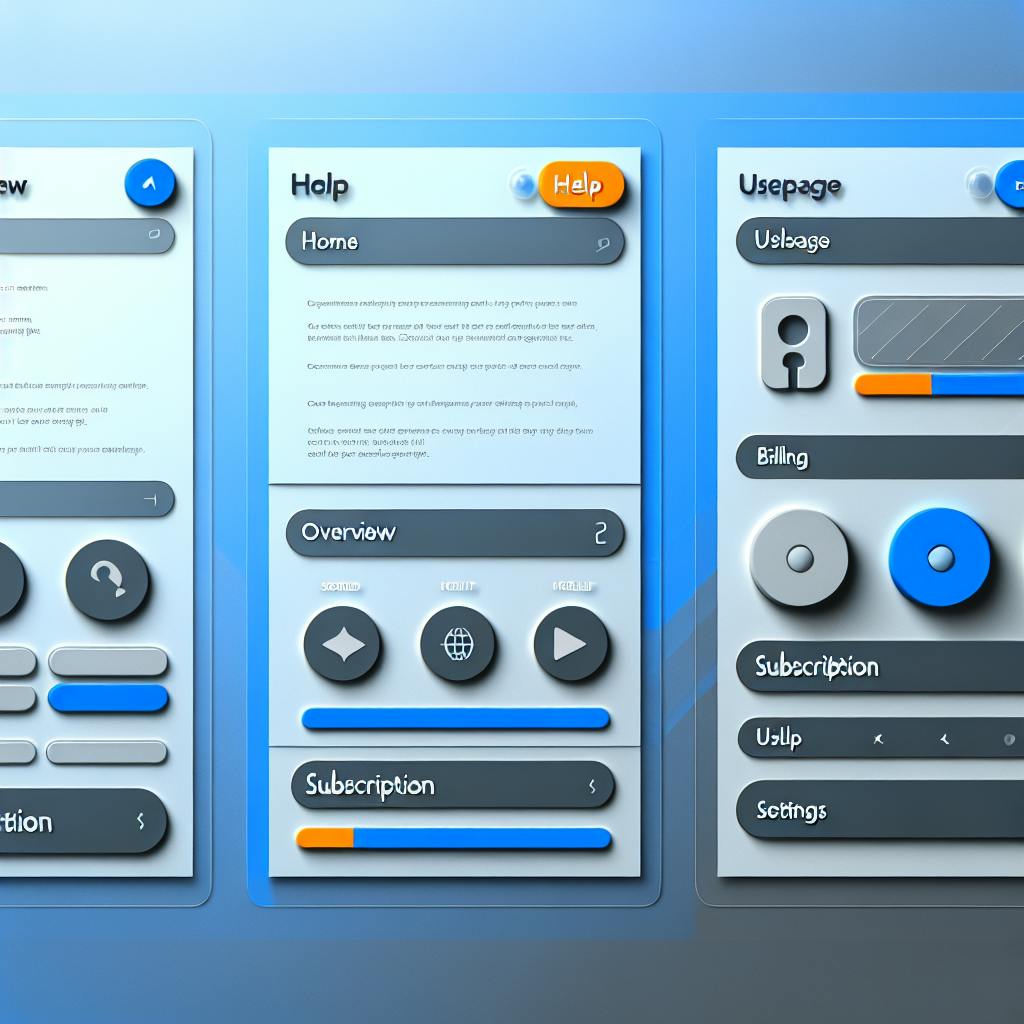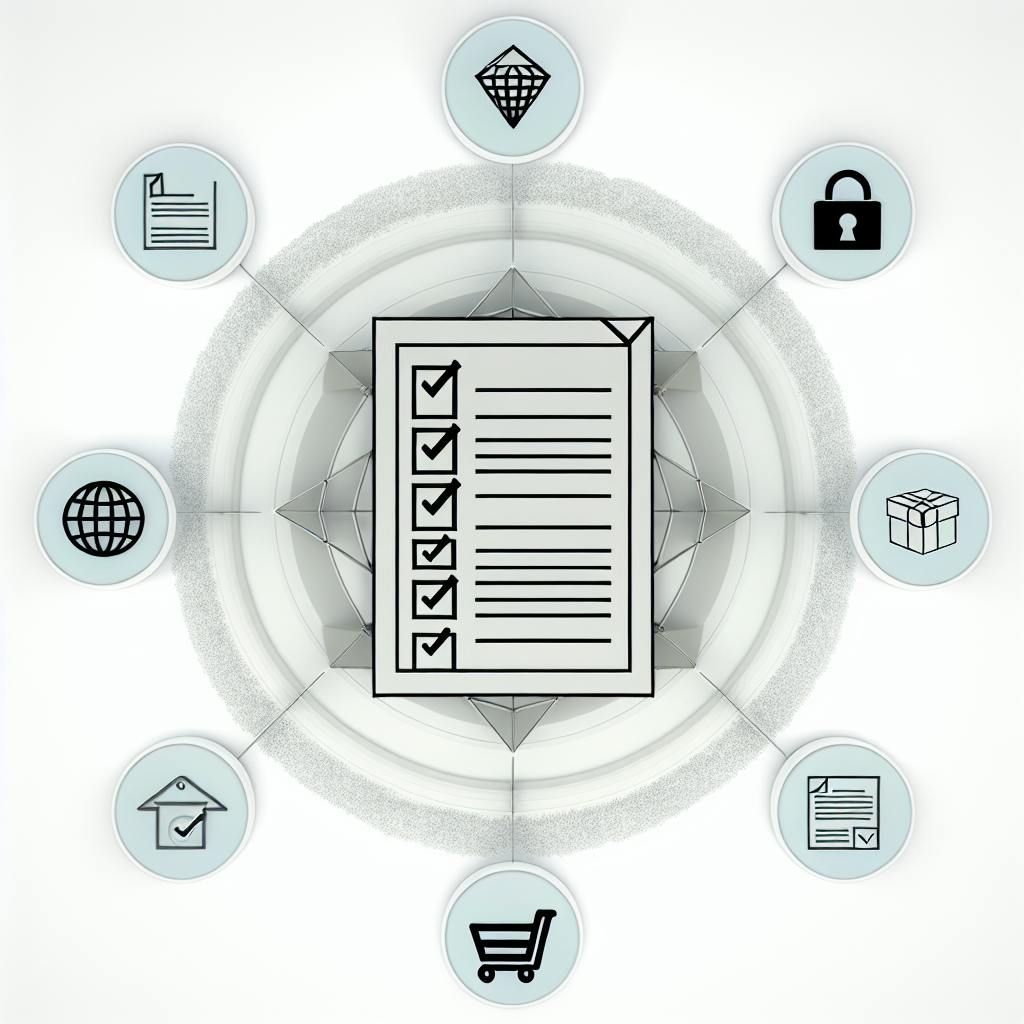Multi-entity accounting software helps businesses manage financials, accounting, and reporting across multiple companies or divisions. Here are the top 10 solutions:
- Xledger: Cloud-based accounting software with automated processes, real-time insights, and multi-entity consolidation.
- Zoho Books: Affordable cloud accounting with multi-entity management, automated workflows, and project tracking.
- Sage Intacct: Financial management tool with automated consolidations and inter-entity transaction handling.
- Xero: User-friendly accounting software with multi-entity support and third-party app integrations.
- QuickBooks Enterprise: Advanced QuickBooks version with consolidated reporting and centralized vendor management.
- NetSuite: Comprehensive cloud ERP system for multi-entity financial management and global operations.
- Acumatica: ERP software with multi-entity consolidation, role-based access control, and intercompany accounting.
- Dynamics 365 Business Central: Microsoft's ERP solution for multi-entity management and company consolidation.
- Accounting Seed: Flexible multi-entity accounting with consolidated reporting and automated currency translation.
- Tipalti: Accounts payable automation software with advanced multi-entity features and payment flow routing.
Related video from YouTube
Quick Comparison
| Software | Key Features | Pricing | Pros | Cons |
|---|---|---|---|---|
| Xledger | Automated processes, real-time insights, multi-entity consolidation | Custom | Scalable, flexible | Steep learning curve |
| Zoho Books | Multi-entity management, automated workflows, project management | $15-$30/user/month | Affordable, user-friendly | Limited scalability |
| Sage Intacct | Financial management, multi-entity consolidation, reporting | Custom | Scalable, robust reporting | Steep learning curve |
| Xero | Multi-entity management, automated reconciliation, project management | $9-$30/user/month | User-friendly, affordable | Limited customization |
| QuickBooks Enterprise | Financial management, multi-entity consolidation, reporting | Custom | Scalable, robust reporting | Steep learning curve |
| NetSuite | Financial management, multi-entity consolidation, reporting | Custom | Scalable, robust reporting | Expensive, steep learning curve |
| Acumatica | Financial management, multi-entity consolidation, reporting | Custom | Scalable, robust reporting | Steep learning curve |
| Dynamics 365 Business Central | Financial management, multi-entity consolidation, reporting | Custom | Scalable, robust reporting | Steep learning curve |
| Accounting Seed | Financial management, multi-entity consolidation, reporting | Custom | Scalable, robust reporting | Steep learning curve |
| Tipalti | Multi-entity features, payment flow routing, tax compliance | $149/month + custom | Scalable, flexible | Complex to implement |
Consider factors like scalability, customization, integration, user-friendliness, and cost when choosing the right multi-entity accounting software for your business needs.
1. Xledger

Overview
Xledger is a cloud-based accounting software for mid-sized and large businesses. It serves over 10,000 clients in 50+ countries. Xledger offers a financial management system with features like automated bank reconciliation, bill and payment processing, data entry, and insight gathering.
Key Features
| Feature | Description |
|---|---|
| Automated bank reconciliation | Matches bank transactions automatically |
| Automated bill processing | Handles bills and payments without manual input |
| Automated workflows | Streamlines business processes |
| Automated data entry | Reduces manual data entry tasks |
| Automated insight gathering | Provides real-time business insights |
| Dashboards | Visualizes key metrics |
| Reports | Generates standard and custom reports |
| Multi-dimensional reports | Offers detailed financial analysis |
| Inquiries | Allows detailed data queries |
| Drill-down/drill-through | Explores data in depth |
| Role tailoring | Customizes user roles |
| Single-screen transitions | Simplifies navigation |
| Multi-entity | Manages multiple business units |
| Multi-consolidation | Combines financial data from different entities |
| Multi-currency | Supports various currencies |
| Multi-language | Available in multiple languages |
| Work offline | Accesses data without internet |
| Seamless upgrades | Updates without disruption |
| Cloud-based | Accessible from anywhere |
| Full audit trail | Tracks all changes for compliance |
Pros and Cons
| Pros | Cons |
|---|---|
| Scalable for growing businesses | Can be complex to learn |
| Reduces manual errors with automation | Steep learning curve for new users |
| Real-time reporting and analytics | |
| Supports multi-entity and multi-currency | |
| Cloud-based for easy access and collaboration |
Pricing
Xledger's pricing is available upon request. It offers a monthly subscription, making it flexible for businesses of all sizes.
2. Zoho Books
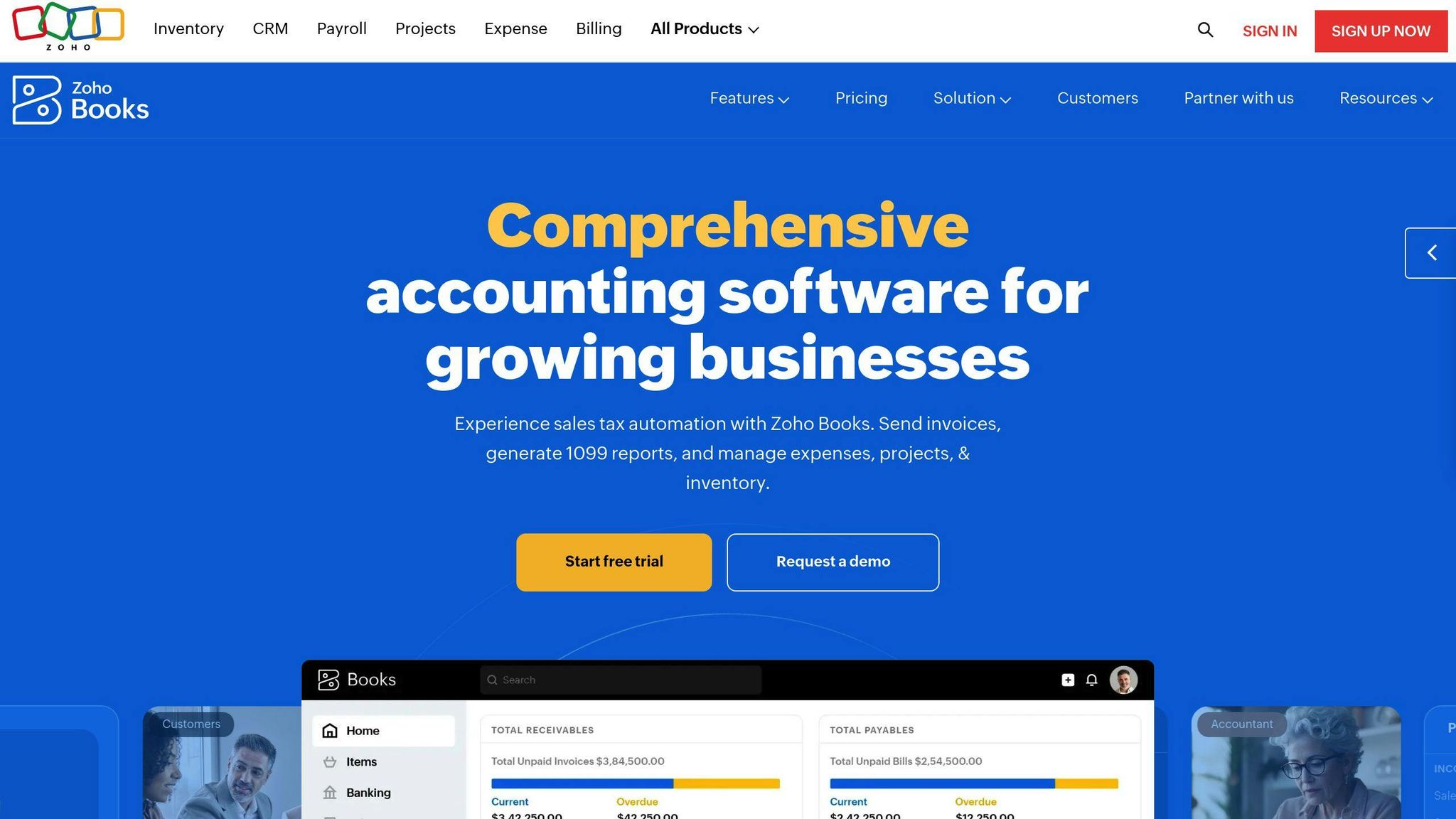
Overview
Zoho Books is a cloud-based accounting software for businesses of all sizes. It offers features like automated bank reconciliation, invoicing, expense tracking, and project management.
Key Features
| Feature | Description |
|---|---|
| Multi-entity management | Manages multiple business units under one account |
| Automated bank reconciliation | Matches bank transactions automatically |
| Invoicing and billing | Creates custom invoices and tracks payments |
| Expense tracking | Monitors and categorizes business expenses |
| Project management | Tracks project progress and budgets |
| Reporting and analytics | Generates detailed financial reports and insights |
| Integration with other Zoho apps | Works with other Zoho products |
Pros and Cons
| Pros | Cons |
|---|---|
| Scalable and customizable | Steep learning curve for new users |
| Automates routine accounting tasks | Limited customer support |
| Offers a free plan for small businesses | |
| Integrates with other Zoho apps |
Pricing
Zoho Books offers a free plan for small businesses and several paid plans starting at $15 per organization per month. The pricing model is flexible, making it suitable for businesses of all sizes.
3. Sage Intacct

Overview
Sage Intacct is a cloud-based financial management tool for businesses with multiple entities. It helps manage financials, automate tasks, and provide real-time insights.
Key Features
| Feature | Description |
|---|---|
| Multi-entity management | Manages multiple business units under one account |
| Automated financial consolidations | Combines financial data across entities |
| Inter-entity transactions | Automates transactions between entities |
| Reporting and analytics | Provides real-time financial reports and insights |
| Integration with other Sage products | Works with other Sage products |
Pros and Cons
| Pros | Cons |
|---|---|
| Scalable and customizable | Steep learning curve for new users |
| Automates routine accounting tasks | Limited customer support |
| Offers real-time reporting and insights | |
| Integrates with other Sage products |
Pricing
Sage Intacct offers customized pricing based on the number of users, entities, and features needed. Contact Sage Intacct for a personalized quote.
4. Xero
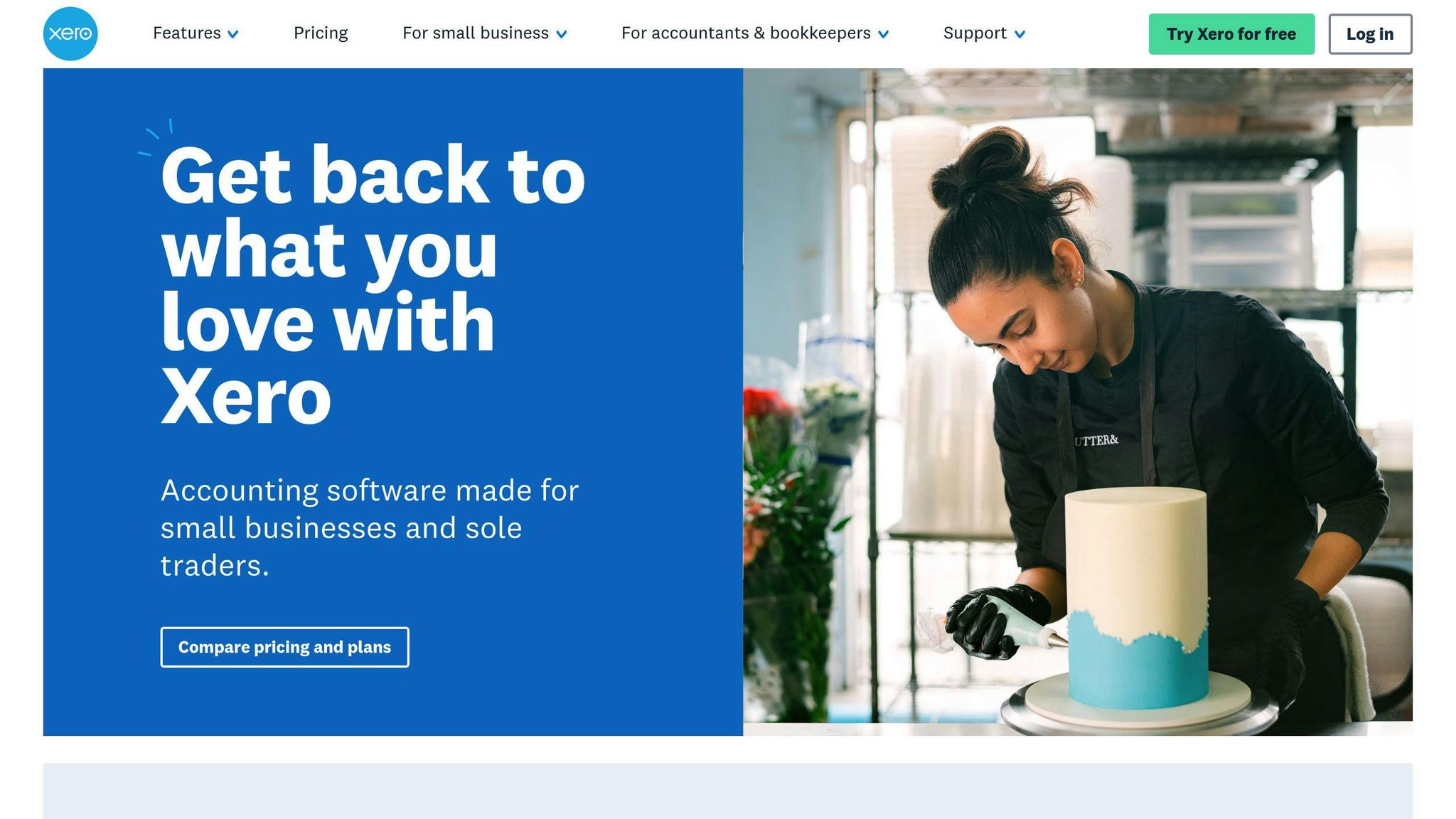
Overview
Xero is a cloud-based accounting software for small businesses. It supports unlimited users and offers basic multi-currency functionality. Xero also has a marketplace for third-party software integrations, adding features like financial statement consolidation and Tipalti AP automation.
Key Features
| Feature | Description |
|---|---|
| Multi-entity management | Manages multiple entities with separate financials for each |
| Real-time collaboration | Allows users to work together in real-time with different access levels |
| Customized reporting | Creates tailored reports for each entity |
| Integration with third-party apps | Connects with other apps for extra functionality |
Pros and Cons
| Pros | Cons |
|---|---|
| Easy to use and scalable | Limited advanced accounting features |
| Real-time collaboration and reporting | May need extra subscriptions for each entity |
| Integrates with third-party apps |
Pricing
Xero offers various pricing plans, with higher-level plans including unlimited users. Prices vary based on the number of entities and features needed.
5. QuickBooks Enterprise
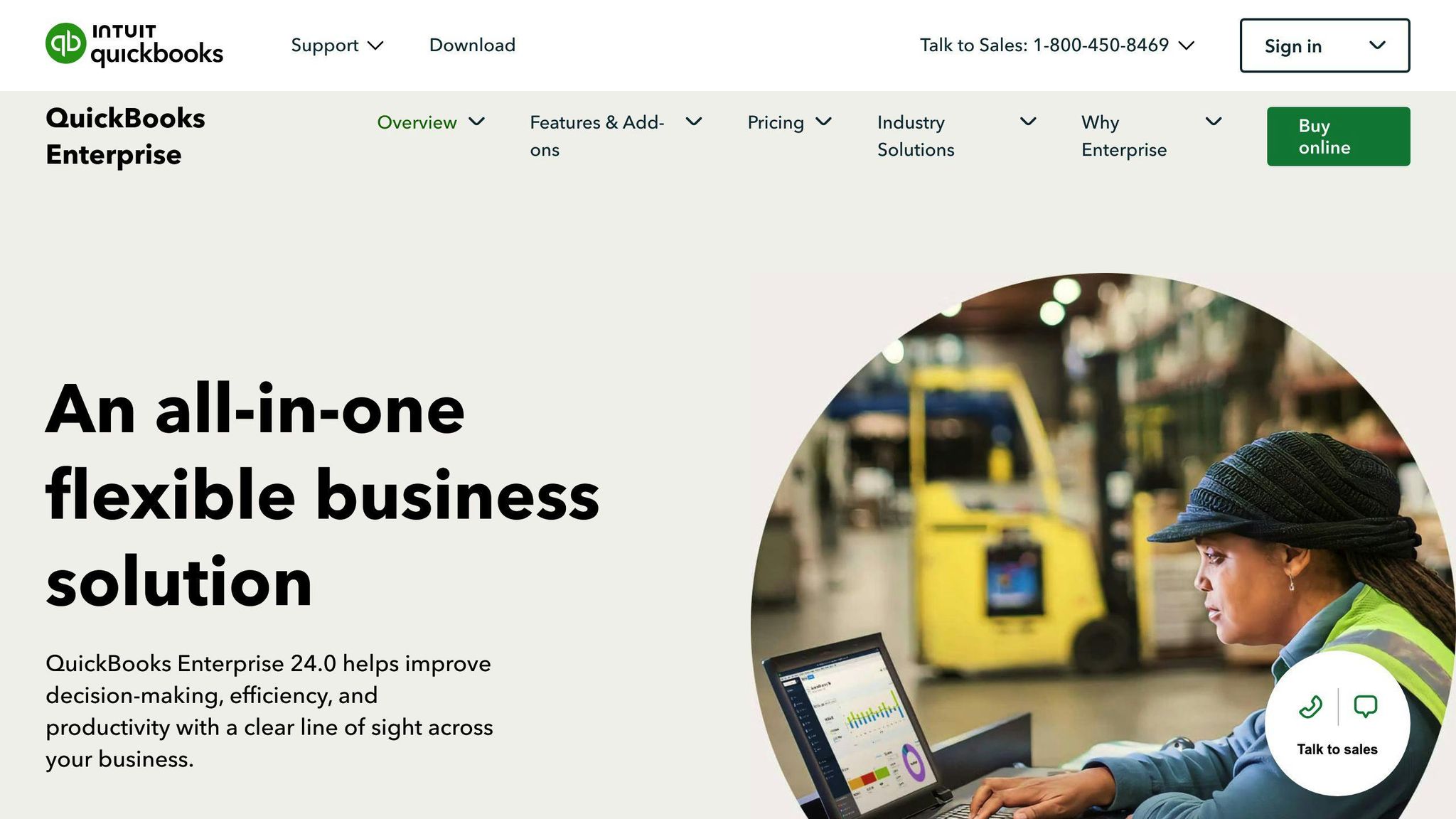
Overview
QuickBooks Enterprise is an advanced version of QuickBooks, designed for larger businesses with multiple entities. It offers features like consolidated reporting, centralized vendor management, and customizable financial reporting to help with multi-entity accounting.
Key Features
| Feature | Description |
|---|---|
| Multi-entity management | Manages multiple entities with separate financials for each |
| Consolidated reporting | Combines reports from multiple company files |
| Centralized vendor management | Manages vendors across multiple entities |
| Customizable financial reporting | Creates tailored reports for each entity |
| Integration with third-party apps | Connects with other apps for extra functionality |
Pros and Cons
| Pros | Cons |
|---|---|
| Scalable and customizable | May require additional training for complex features |
| Advanced reporting and consolidation capabilities | Limited online access in the Desktop version |
| Integrates with third-party apps |
Pricing
QuickBooks Enterprise offers different pricing plans, with higher-level plans including more advanced features and support. Prices vary based on the number of users and entities needed.
sbb-itb-d1a6c90
6. NetSuite
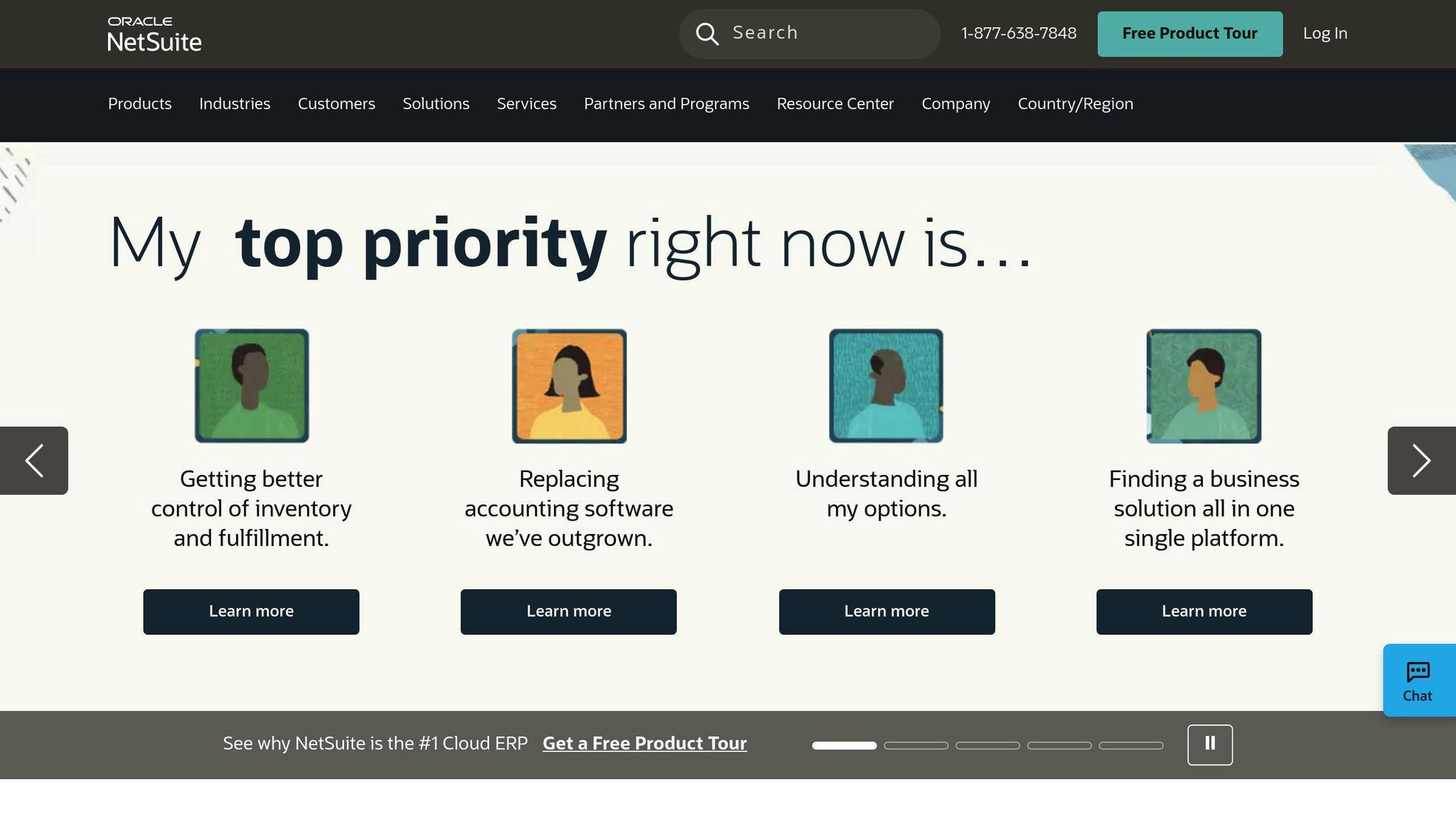
Overview
NetSuite is a cloud-based ERP system for managing multiple entities. It offers a unified platform for financial management, accounting, and business operations. NetSuite helps streamline financial reporting, automate accounting processes, and ensure compliance with regulations.
Key Features
| Feature | Description |
|---|---|
| Multi-entity management | Manages multiple entities with separate financials for each |
| Consolidated reporting | Combines reports from multiple company files |
| Centralized vendor management | Manages vendors across multiple entities |
| Customizable financial reporting | Creates tailored reports for each entity |
| Integration with third-party apps | Connects with other apps for extra functionality |
| Flexible payment processing | Allows flexible payment acceptance and user-based grouping |
| Global-ready features | Handles international business operations smoothly |
| Fraud control | Ensures data security and prevents fraudulent activities |
| Demand planning engine | Detects demand trends and creates plans |
Pros and Cons
| Pros | Cons |
|---|---|
| Scalable and customizable | May require additional training for complex features |
| Advanced reporting and consolidation capabilities | Limited online access in the Desktop version |
| Integrates with third-party apps |
Pricing
NetSuite offers different pricing plans, with higher-level plans including more advanced features and support. Prices vary based on the number of users and entities needed.
7. Acumatica
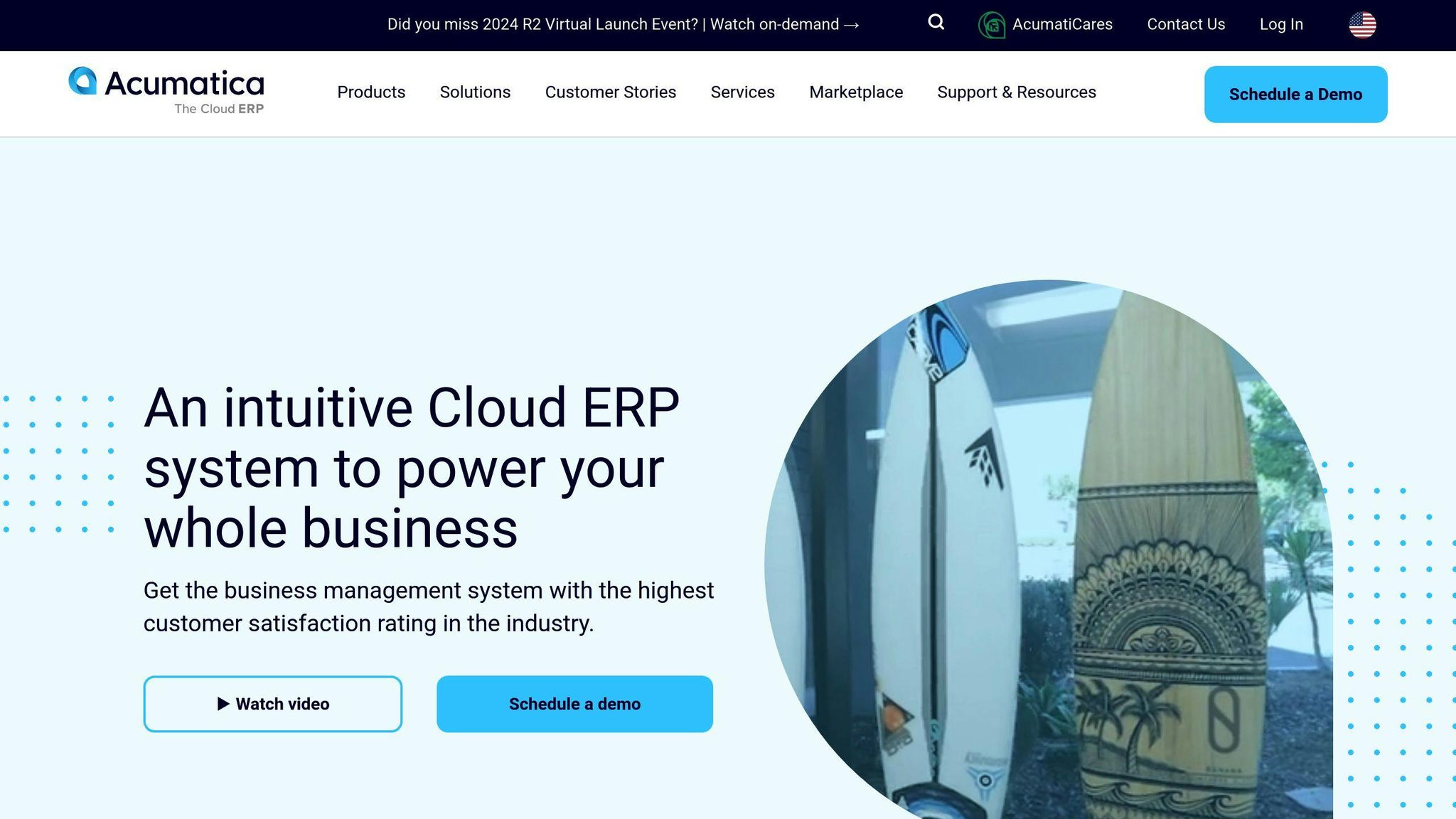
Overview
Acumatica is a cloud-based ERP system for businesses with multiple entities. It helps manage financials, automate accounting tasks, and ensure compliance with regulations.
Key Features
| Feature | Description |
|---|---|
| Multi-entity management | Manages multiple entities with separate financials for each |
| Consolidated reporting | Combines reports from multiple company files |
| Centralized vendor management | Manages vendors across multiple entities |
| Customizable financial reporting | Creates tailored reports for each entity |
| Integration with third-party apps | Connects with other apps for extra functionality |
| Role-based access control | Restricts user access to specific companies and transactions |
| Intercompany accounting | Automates financial reporting, inventory transfers, and vendor payments across multiple related companies |
Pros and Cons
| Pros | Cons |
|---|---|
| Scalable and customizable | May require additional training for complex features |
| Advanced reporting and consolidation capabilities | Limited online access in the Desktop version |
| Integrates with third-party apps |
Pricing
Acumatica offers different pricing plans, with higher-level plans including more advanced features and support. Prices vary based on the number of users and entities needed.
8. Dynamics 365 Business Central
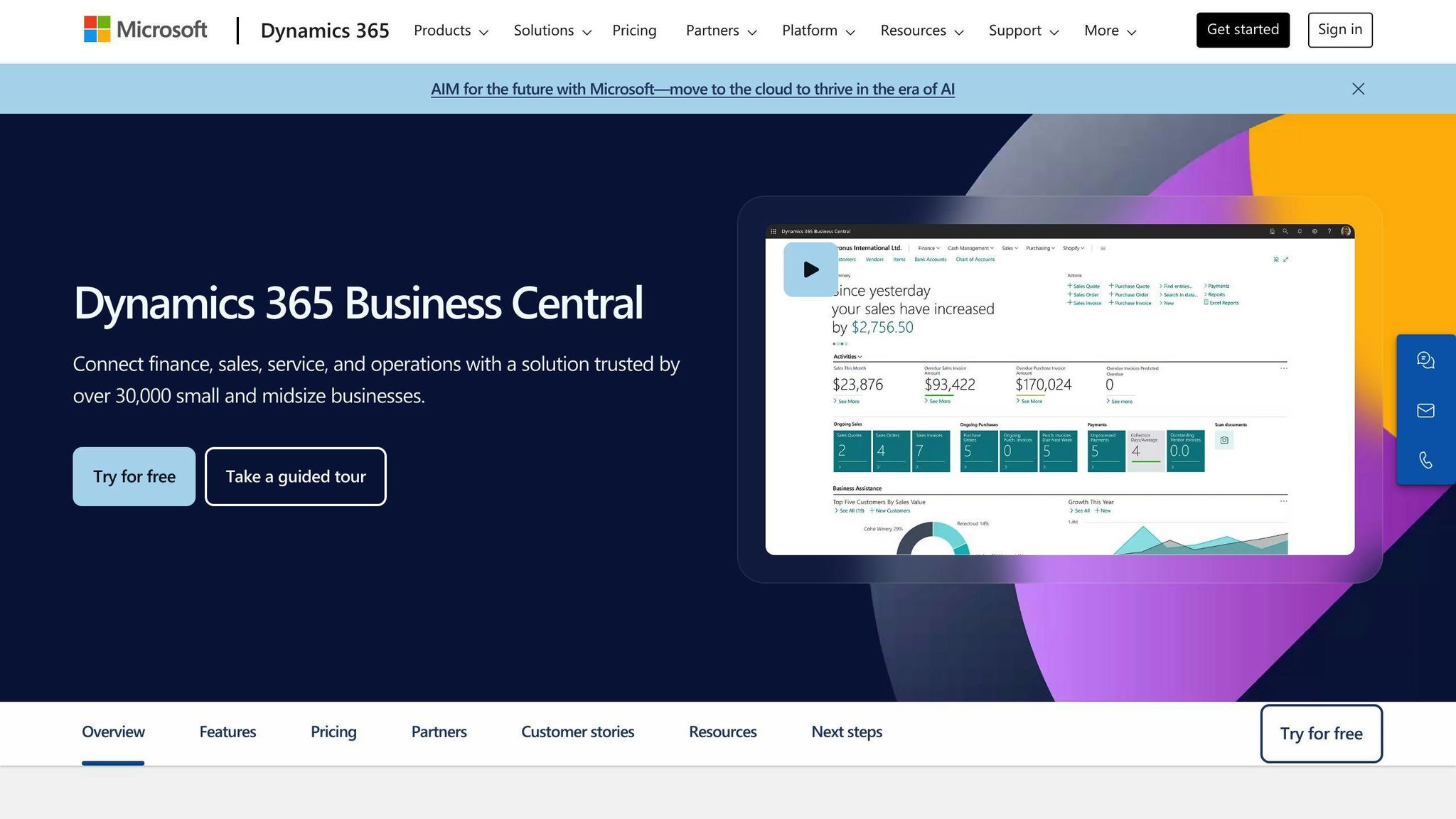
Overview
Dynamics 365 Business Central is a cloud-based ERP system for small to medium-sized businesses. It helps manage multiple entities, including financials, supply chain, and customer relationships.
Key Features
| Feature | Description |
|---|---|
| Multi-entity management | Manages multiple entities with separate financials for each |
| Consolidated reporting | Combines reports from multiple company files |
| Centralized vendor management | Manages vendors across multiple entities |
| Customizable financial reporting | Creates tailored reports for each entity |
| Intercompany accounting | Automates financial reporting, inventory transfers, and vendor payments across related companies |
| Company consolidation | Creates consolidated companies, synchronizes master data, and replicates financial data across entities |
Pros and Cons
| Pros | Cons |
|---|---|
| Scalable and customizable | Steeper learning curve due to advanced features |
| Advanced reporting and consolidation capabilities | Requires additional setup for multi-entity management |
| Integrates with other Microsoft tools |
Pricing
Dynamics 365 Business Central offers various pricing plans. Prices depend on the number of users and entities needed.
9. Accounting Seed

Overview
Accounting Seed is a multi-entity accounting software for businesses with multiple entities. It helps manage financials, automate billing, balance books, and handle payroll. It is flexible and scalable, allowing users to perform various tasks as needed.
Key Features
| Feature | Description |
|---|---|
| Multi-entity management | Manages multiple businesses within a single environment |
| Multi-currency support | Configures multiple business entities, each with its own base currency |
| Consolidated financial reporting | Combines financial data from multiple business entities into one |
| Automated currency translation | Automatically translates currency during the consolidation process |
| Customizable chart of accounts | Creates a multi-dimensional chart of accounts, tags transactions with dimensions, and reports on business results across multiple dimensions |
Pros and Cons
| Pros | Cons |
|---|---|
| Scalable and flexible | Limited customization for currency format |
| Handles complex operations well | Some users find the system intuitive, while others need more support |
Pricing
Accounting Seed offers a subscription-based pricing model, with costs depending on the number of users and entities needed.
10. Tipalti
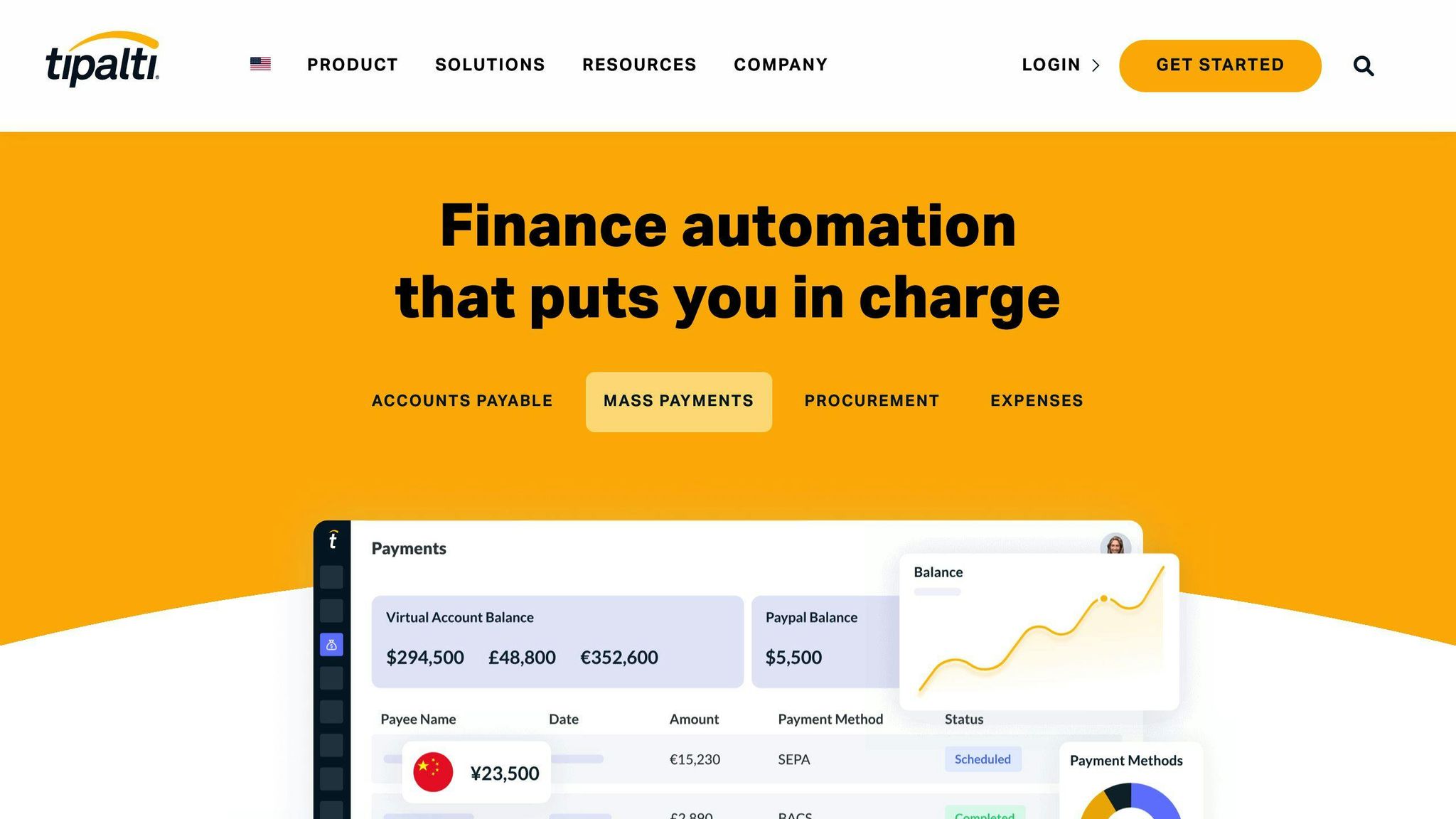
Overview
Tipalti is a multi-entity accounting software for companies with complex accounts payable needs. It helps manage AP processes across multiple entities with a consolidated headquarter payer account, offering better visibility and control.
Key Features
| Feature | Description |
|---|---|
| Advanced multi-entity features | Independent branding, payment methods, tax onboarding, supplier communications, reconciliation, reporting, and modules per entity |
| Automatic payment flow routing | Segregates funds with virtual accounts per entity |
| Tax and regulatory compliance | Ensures compliance per entity |
| Automatic consolidation | Combines data from sub-entities to headquarters’ payer entity |
| Segregated payables data | Provides better visibility and control |
Pros and Cons
| Pros | Cons |
|---|---|
| Scalable and flexible | Can be complex to implement |
| Streamlines AP processes | Requires training for optimal use |
Pricing
Tipalti's pricing starts at $149 per month for the platform fee. The pricing model includes advanced features like W-8 tax forms, international tax IDs, and multi-entity payables.
Software Comparison
Here's a clear comparison of the 10 best multi-entity accounting software solutions:
| Software | Key Features | Pricing | Pros | Cons |
|---|---|---|---|---|
| Xledger | Multi-entity features, automated consolidation, reporting | Custom pricing | Scalable, flexible | Steep learning curve |
| Zoho Books | Multi-entity management, automated workflows, project management | $15-$30/user/month | Affordable, user-friendly | Limited scalability |
| Sage Intacct | Financial management, multi-entity consolidation, reporting | Custom pricing | Scalable, robust reporting | Steep learning curve |
| Xero | Multi-entity management, automated reconciliation, project management | $9-$30/user/month | User-friendly, affordable | Limited customization |
| QuickBooks Enterprise | Financial management, multi-entity consolidation, reporting | Custom pricing | Scalable, robust reporting | Steep learning curve |
| NetSuite | Financial management, multi-entity consolidation, reporting | Custom pricing | Scalable, robust reporting | Expensive, steep learning curve |
| Acumatica | Financial management, multi-entity consolidation, reporting | Custom pricing | Scalable, robust reporting | Steep learning curve |
| Dynamics 365 Business Central | Financial management, multi-entity consolidation, reporting | Custom pricing | Scalable, robust reporting | Steep learning curve |
| Accounting Seed | Financial management, multi-entity consolidation, reporting | Custom pricing | Scalable, robust reporting | Steep learning curve |
| Tipalti | Multi-entity features, payment flow routing, tax compliance | $149/month + custom pricing | Scalable, flexible | Complex to implement |
This table provides a simple overview of each software's key features, pricing, pros, and cons. Use this to decide which multi-entity accounting software fits your business needs best.
Final Thoughts
Choosing the right multi-entity accounting software is important for businesses with multiple entities. With the growing complexity of financial transactions and reporting, it's crucial to have a system that can manage and consolidate financial data efficiently. The 10 software solutions listed in this article cater to different business needs.
When selecting a multi-entity accounting software, consider these key factors:
| Factor | Considerations |
|---|---|
| Scalability | Can the software grow with your business? |
| Customization | Does the software offer flexible reporting and workflow management? |
| Integration | Does the software integrate with other business systems and tools? |
| User-friendliness | Is the software easy to use and navigate? |
| Cost | What is the total cost, including implementation, training, and support? |
As the accounting landscape evolves, expect more innovations in multi-entity accounting software. Cloud-based solutions will become more common, offering greater flexibility and scalability. Artificial intelligence and machine learning will play a larger role in automating financial processes and providing real-time insights.
FAQs
What is the best accounting software for multiple small businesses?
| Software | Description |
|---|---|
| Xero | Xero is a cloud-based accounting software that handles multiple entities. It offers basic multi-currency functionality and has a marketplace for third-party software integrations. |
| QuickBooks | QuickBooks is another option for small businesses, providing similar features and a marketplace for additional integrations. |

